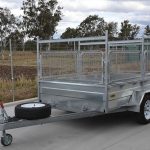11 Moving Tips To Make Your Move Easier
1. Make a list or lists of what you need to do and when
Write everything down! You’ll thank yourself later. Before you pack, create a simple record keeping system. Creating a computer printed list of numbers with a space to write the contents will save you time!
Or have a spiral-bound notebook for the job. You’ll place a number on EVERY box you pack and list the contents on your list. Don’t put the list down unless it’s in a place that you will remember – The same place where you’ll find your goods labels, marking pens, sticky tape, and other bits and pieces. When describing the box contents, be specific — “A-D files” is better than “files”, and “Cooking dishes” rather than “misc. kitchen”.
2. Have plenty of boxes handy
You’ll need plenty of boxes and more than you think, and having enough boxes will make your life easier! Ask your Self Storage Manager for the sizes and quantity you will need.
Set aside at least 10 cartons to use for last minute items on moving day, such as bedding, clothing, and cleaning gear. You’ll need strong packaging tape to close up the boxes securely. Use butchers paper available from your manager or packing paper or bubble wrap to wrap and cushion household goods. Again, you’ll need lots more supplies than you thought, so get extra so the packing can go smoothly.
3. Utilize Port A Robe styled boxes.
These tall boxes are perfect for bulky, lightweight items such as comforters, pillows, and blankets, as well as clothes that need to remain hanging. You can also use them for blankets, shoe boxes, and other bulky items such as fabric rolls, large baskets, or gift wrap tubes. Don’t make the boxes too heavy to lift! Not all removalists look like Arnie!
4. Strategise wardrobe box use.
A few days before your move, fill some sturdy handled shopping bags with bulky closet items such as shoes, sweaters, belts, and jeans. On moving day, fill the bottom of the wardrobe boxes with some of the shopping bags, then add your hanging clothing. Pack hanging items tightly so things won’t move around and fall off of hangers. Finally, cover the shoulders of your clothes (a dry cleaning bag works well), then add a few purses or sweaters on top. You’ll have fewer boxes, and closet items remain together
5. Colour code & coordinate.
A colour for each room makes it easy for anyone to place a box in the right room. Apply coloured stickers on the box near the box number. In your new residence, put a matching sticker on the door to each room. The movers will know where to put everything when they arrive at the destination. It’s also helpful to post a big sign on the wall in the room where you want boxes stacked, (“Boxes here please”) to keep them out of furniture and traffic areas.
6. Keep things together.
Insist on keeping things together when you or the movers are packing boxes. Keep bookends with books, light bulbs with lamps, and extension cords with appliances. Small, loose parts can be attached to the item they belong to with tape or placed in small envelopes — to keep picture hooks with pictures, shelf brackets with a bookcase, a special spanner and its bolts with the wall unit or cabinet. Keep larger corresponding items (such as a cables for the hi fi and TV in resealable bags, and tape these to the underside or back of the item. As a backup, have a “Parts Box” open on the kitchen counter and fill it with cables, cords, parts, pieces, brackets, or nails that are removed from any items of furniture. Keep this box with you, or mark it well with a rainbow of coloured stickers so it can be easily located on move-in day.
Hi FI and AV gear is complicated! A multimedia receiver could have as many 20 or more connections. Turn off all equipment to start. Disconnect speaker cables to start. Label the ends of the cables and reuse them in the same order. This will reduce the chances of getting cables out of ‘Phase”. Its essential for cables to reconnected the same way to ensure your speakers sound the same.
Components once removed should be cleaned. Dust is the biggest killer of Hi Fi gear – remove all dust, use a paintbrush to clean around fascias and terminals.
TV’s need to be packed very well to avoid damage and Plasma and LCD flat screens must remain upright. If you don’t have the original carton for your TV, ask the Manager to order you one.
Complicated hi fi setups can be mad a bit easier with good labels on each lead. Colour coding works as well. Some cables are specific to equipment, for example HDMI 1.4 cables are different to HDMI 1.3. Mix them up and the next 3D movie might be 2D instead of 3D.
Package all gear in boxes with plenty of padding. HI FI Gear is delicate. DVD players often have a device to “Park the Heads” for transit. Have a look on the bottom of the unit. Turntables should have the arms secured so the styles cant hit the platter in transit.
Protect the frontal area of your speakers. The cones are prone to damage and older speakers can tear at the first touch, rendering them useless.
If you’re not sure about hooking all your gear back up, consider engaging a home theatre specialist to reinstall your system.
7. Pack ahead.
Anything you can pack ahead will save you time on moving day. If it’s summer, get your winter clothes out of the way. You don’t really need 5 radios or TV’s around your house for the last few days! Box up your shampoo and extra toothpaste and live out of a travel cosmetic case for the last week or two. Reduce down cooking utensils and food supplies to bare essentials. Wastebaskets can also be packed (put things in them!) while you switch to using plastic grocery bags (hang them on a cabinet door or door handle to collect rubbish.)
8. Consolidate cleaning supplies.
If you must clean your old place after moving out, put together a kit of basic cleaning supplies and rags. Clean anything possible ahead of time (the inside of kitchen cupboards, the oven, windows, etc.), and if possible, vacuum each room as movers empty it. Otherwise, do it later
9. Use your luggage.
Fill luggage and duffle bags with clothing, sheets, towels, and paper goods. Even for local moves you’ll be able to quickly spot your navy suitcase holding your favorite sweaters, whereas “Box #189” might remain elusive for days.
10. Safeguard valued items.
It’s a good idea to keep valuable possessions, such as silverware, collections, or antiques, with you. If you have a long move and no room in your car, bury the items in a box titled “Misc. from kitchen”. Check your homeowner’s insurance to see how you are covered during the move and if you need additional insurance from the removalist. Also, find out what paperwork (receipts and photos) you might need to file a claim in case of loss. Backup your computer. Old computers don’t like movement and can fail on restart. Take your backups with you in the car.
11. Keep important papers with you.
Your list of “important” papers might include: birth certificates, school records, moving quotes, new job contacts, company numbers, recent bank records, current bills, phone lists, Real Estate info, maps, and more. Don’t leave these with the mover. Keep them with you!
The Final Moving Tip: Go To The Source
If you have any questions or concerns, your Amberley Self Storage Manager can recommend you the best way to pack your valuables and where to buy moving supplies. Contact us today to learn more!







